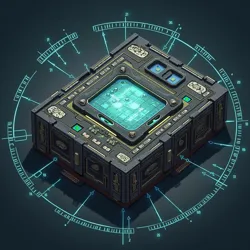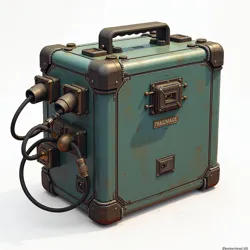Flux Mapping Techniques
 A modern flux mapping array utilizing crystallized silence sensors and enchanted recording equipment
A modern flux mapping array utilizing crystallized silence sensors and enchanted recording equipmentFlux mapping techniques encompass the specialized methods and technologies used to detect, measure, and visualize thaumic flux patterns across both physical and metaphysical spaces. Developed initially during the Third Age of Enlightenment, these techniques have evolved from simple dowsing methods to highly sophisticated systems that combine advanced thaumaturgical instrumentation with precise mathematical modeling. The field represents a crucial intersection of practical magic and theoretical thaumaturgy, enabling everything from basic magical infrastructure planning to complex void realm research.
Historical Development
The earliest attempts at flux mapping date back to the primitive dowsing techniques used by wandering mages of the Age of Shadows. These practitioners utilized simple tools crafted from resonant metals to detect areas of heightened magical energy, though their results were often inconsistent and highly subjective. The first systematic approach to flux mapping emerged when the Meridian Institute of Chromatic Sciences developed the Temprin Grid System - a standardized method for documenting flux intensities across geographical regions.
A major breakthrough occurred with the invention of the Flux Resonance Matrix by Dr. Elowen Brightweave during her early work at the Academy of Spectral Studies. This revolutionary device allowed for the first time the simultaneous measurement of flux patterns across multiple dimensional frequencies, leading to the discovery of previously unknown relationships between different types of magical energy flows. The matrix's design principles continue to form the foundation of modern flux mapping equipment.
Core Methodologies
Modern flux mapping relies on a combination of direct measurement and theoretical modeling. The primary detection mechanism typically involves arrays of crystallized silence sensors arranged in precise geometric patterns determined by the Laws of Arcane Geometry. These arrays are calibrated to detect variations in thaumic energy levels as small as 0.001 Temprin Units, allowing for extremely detailed mapping of local flux patterns.
The raw data collected by these sensor arrays undergoes extensive processing through specialized enchanted calculation engines. These devices employ principles derived from the Theory of Chromatic Interconnection to translate the complex multidimensional measurements into comprehensible visualizations and numerical models. The Guild of Systematic Thaumaturgy maintains strict standards for this processing to ensure consistency and reliability across different mapping installations.
Equipment and Instrumentation
 A field researcher's portable flux mapping kit, showing various specialized sensors and recording devices
A field researcher's portable flux mapping kit, showing various specialized sensors and recording devicesThe basic toolkit for flux mapping includes several essential components. At its core is the thaumic resonator, a precisely calibrated device that generates a reference frequency against which ambient flux patterns can be measured. This is typically paired with an array of void chambers that serve as controlled environments for baseline measurements.
More advanced mapping operations employ enchanted containment units modified to function as mobile sensing platforms. These units can be deployed in formations that allow for dynamic tracking of flux patterns as they change over time. The development of miniaturized temporal stasis fields has enabled the creation of portable mapping equipment, though these devices sacrifice some precision for convenience.
Applications
The practical applications of flux mapping extend across numerous fields. Urban planners use flux maps to optimize the placement of magical infrastructure, ensuring that new construction doesn't disrupt natural thaumic flow patterns. The Department of Chromatic Containment relies heavily on detailed flux mapping data to monitor potentially dangerous anomalies and prevent incidents similar to the infamous Umbral Incident.
Research institutions employ advanced mapping techniques to study fundamental questions about the nature of magical energy. The discovery of flux nodal points - locations where multiple thaumic currents intersect - has led to significant advances in our understanding of how magical energy moves through space and time. These findings have proven particularly valuable in the study of void realm manifestation and the development of more efficient magical transportation systems.
Challenges and Limitations
Despite significant technological advances, flux mapping continues to face several fundamental challenges. The inherently dynamic nature of thaumic flux means that maps can become outdated quickly, requiring constant updating and recalibration. Additionally, certain phenomena, such as the effects of liquidized shadow on local flux patterns, remain difficult to measure accurately with current technology.
The presence of powerful magical artifacts or areas of extreme magical activity can create interference that makes accurate mapping impossible. The International Council of Chromatic Control maintains a registry of such locations, known as flux blind spots, where alternative measurement techniques must be employed. These typically involve indirect observation methods based on the effects of flux patterns on surrounding areas rather than direct measurement.
Future Developments
Current research in flux mapping focuses on developing more sensitive detection methods and improving the accuracy of long-term flux pattern predictions. Experimental techniques involving crystallized thought as a sensing medium show promise for mapping previously undetectable subtle variations in thaumic energy fields. The integration of these new methods with existing systems represents one of the most active areas of research in modern thaumaturgy.
Safety Considerations
The practice of flux mapping carries inherent risks due to exposure to concentrated magical energies. Practitioners must follow strict safety protocols established by the Guild of Systematic Thaumaturgy, including the use of protective equipment and regular health monitoring. Particular care must be taken when mapping areas of high flux density or regions known to experience frequent void realm manifestation.
See Also
- Thaumic Field Theory
- Flux Density Analysis
- Magical Surveying Principles
References
- "Standard Procedures for Thaumic Cartography" - Guild of Systematic Thaumaturgy
- "Advanced Flux Mapping and Analysis" - Meridian Institute of Chromatic Sciences
- "Safety Protocols in Magical Surveying" - Department of Chromatic Containment